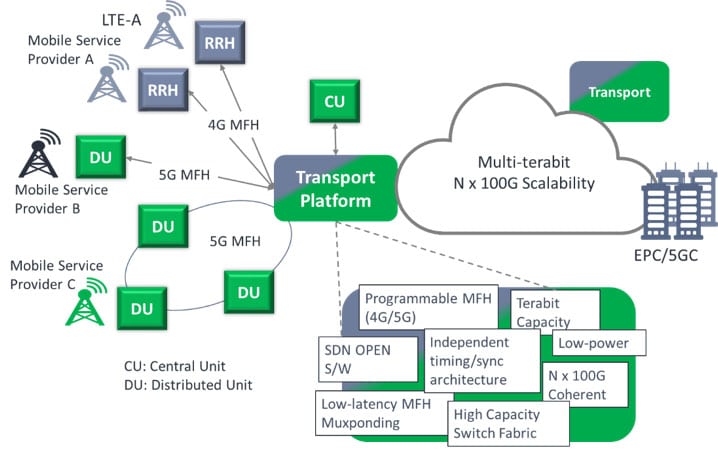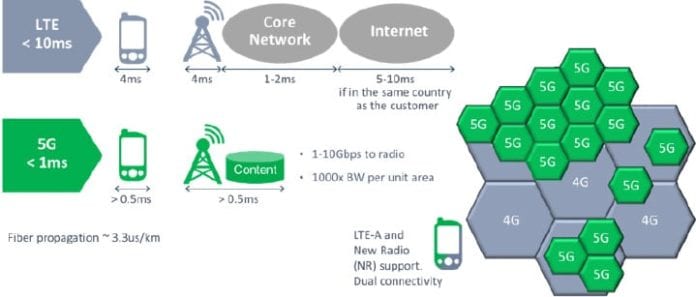When we hear 5G, we automatically tend to think of incredibly fast connections with extraordinarily low latency for our mobile broadband experience. However, the 5G experience is more than just mobile broadband. 5G is a transformation that enables a multitude of services with diverse requirements that can be up to 1,000 times higher in speed and 1,000 times lower in latency than previous standards, as depicted in figure 1.
The 5G transformation is more than new radio (NR) technology alone, but also the ability to use existing LTE radio and support both NR and LTE connectivity with the same user device. Enabling this is the underlying transport infrastructure and network architecture. Today, consumers are enjoying an even better LTE mobile experience as result of new low-latency, high-capacity radio access network (RAN) transport architecture and technology such as centralized RAN (C-RAN), mobile fronthaul (MFH) and high-precision timing and synchronization.

What are the capacity, timing and synchronization requirements of RAN transport? Well, its all about the services and the radio. The first limitation is the law of physics. The speed of light is 3 x 108 meters per second in a vacuum, and while it travels a bit slower in a fiber optic cable and at different speeds for different wavelengths, let’s assume 3.3 microseconds (ms) per kilometer (km). Already we can see that time-critical content cannot traverse too great a distance or travel across an expansive network and still assure service latency of less than one millisecond. Thus, content is moved closer to the service point for latency-critical applications or a better mobile quality of experience (QoE). This is referred to as multi-access edge computing (MEC), wherein the network service edge is closer to the end user. Easy enough – now what about the radio?

The addition of small cells for high-capacity 5G radio means that a corresponding amount of RAN transport connectivity and capacity is needed. It’s estimated that 5G cell capacity will increase at least tenfold and multiplying this increase by the number of cells means RAN transport will need to scale to terabits per second of capacity.
As more cells are added, tighter coordination of the cells for minimizing interference and optimizing spectrum capacity requires very low latency and precision timing and synchronization. For LTE-A, enhanced inter-cell interference coordination (eICIC), an interference control technology, enables operators to increase network capacity to keep up with fast-growing traffic. This is especially crucial in crowded metropolitan areas. Another LTE-A technology for increasing mobile broadband QoE is coordinated multipoint (CoMP). This requires very close coordination between several geographically separated LTE-A baseband nodes as they dynamically coordinate transmissions and the processing of the received signals. The tighter the synchronization, the better the CoMP performance.
These two time-critical technologies depend on RAN transport to assure low latency and precision timing and synchronization. As a result, C-RAN has emerged as the architecture to optimize CoMP performance while also reducing costs at the cell site by centralizing the baseband units (BBUs) away from the cell site and minimizing cell site equipment. Raw digital radio (Common Public Radio Interface or CPRI) from the remote radio units (RRUs) to the centralized BBUs is transported using MFH fiberoptic or microwave technology. Dedicated CPRI fiber links are commonly used and sometimes optimized by daisy chaining multiple RRUs on to one CPRI channel. However, the maximum rate of CPRI and fiber availability will limit the addition of new RRUs and expansion of 5G radios at the cell site unless more fiber is deployed or wavelength-division multiplexing (WDM) technology is used.
Due to simplicity, WDM CPRI is typically done with one CPRI channel per optical channel. While Optical Transport Network (OTN) technology has been used to multiplex multiple CPRI channels onto one optical channel to reduce cost, it hasn’t been a solution to achieve CoMP performance in all networks. A thin OTN-like digital wrapper technology has been used to multiplex CPRI while meeting CoMP requirements. Whatever technology is used to transport CPRI, physics prevails with 3.3 ms/km signal propagation, requiring consideration in network planning since a difference of 1.5 ms between cells would make CoMP ineffective. As a result, some CPRI transport technologies employ delay compensation to ease such network constraints.
In transitioning to 5G, the timing and synchronization requirements are significantly more stringent, as summarized in figure 3. The 5G time-division duplex (TDD) frame structure synchronization to support proper frame alignment for 5G NR is similar to the requirements for LTE-A cells separated by less than 3 km. To get the ultra-high capacity benefits of 5G, technologies like carrier aggregation (CA) and beamforming with massive multiple input, multiple output (MIMO) antennas and radios require exceptionally tight synchronization. Transport is even more crucial for 5G radio performance, resulting in standards organizations defining new protocol formats and specifications for 5G MFH, with an almost tenfold reduction in CPRI transport capacity.

The challenge that exists is deploying a RAN infrastructure and transport equipment for LTE-A that will not be obsolete for 5G. If one had to make a wish list for a transport platform to support 5G transformation, it could look like something shown in figure 4 – a platform that not only supports the capacity and low-latency 5G interfaces but also multiple mobile service providers over the same network. This would drastically reduce network complexity and costs, as each service provider would have its own timing and synchronization domain, while typical networking equipment supports only one timing domain and thus only one service provider. As a result, a network supporting three mobile service providers could have a threefold reduction in the number of transport equipment.
 Figure 4: 5G Transformation Transport Platform
Figure 4: 5G Transformation Transport Platform
The radio spectrum is a mobile service provider’s greatest asset. Even now with LTE-A, transport timing and synchronization is an important factor for enhancing radio performance and improving mobile broadband QoE. It will be even more so with 5G as even higher-performance radio is deployed.

